As a beer writer, I only get invited to events at restaurants infrequently. When I get an email suggesting that I should go to a dinner hosted by Thailand’s ambassador to Canada, it’s something of a rarity. This is an important governmental figure from another country. It would be downright gauche to refuse.
The reason for the event is due to a new program called Thai Select. The idea here is that the program certifies the authenticity of the food being served and allows the customer a degree of certainty when choosing a restaurant. Essentially, better than 60 percent of the items on the menu are meant to be authentic Thai dishes using cooking methods like you’d find in Thailand. There are two groups: Select and Select Premium. This is more or less delineated upon the quality of the food, décor and experience.
Linda Modern Thai in The Shops at Don Mills was the first restaurant in Canada to receive the Select Premium designation, so it’s fitting that the dinner expanding awareness of the program should be held there.
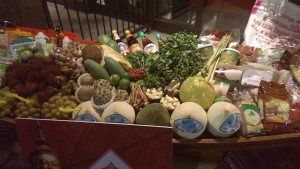
A rather nicely arranged collection of ingredients on the red carpet. Did I mention the red carpet? Yeah, there was a red carpet. I feel all special.
That said, I’m not really a restaurant critic. I’m a beer writer. Fortunately, a representative from Singha was on hand to provide me some explanation of the brand and, y’know, a method of appearing legitimately involved in the proceedings. I’m all for turning up and eating a lot of really high quality Thai food and not contributing anything, but I always feel like I should pull my weight.
It turns out that Singha is more interesting than I would have originally thought. We’re spoilt in North America by the beer cultures that we’ve inherited from Europe. In other parts of the world, one of the things that tended to happen was that European colonial powers in the 19th century would plant a flag and set up services to their benefit. Sometimes, these were breweries. Look at Mexico and Dos Equis. Why in the world, you should probably ask, is a Vienna Lager a widespread quantity? The brief Hapsburg experiment. That’s why. Look at Japan, whose brewing industry is more or less directly influenced by Dutch sailors setting up a beer hall in the 17th century.
Usually what happens when you’ve got cultures that don’t have the depth of brewing tradition you find in Europe is that they set up beers based loosely on whatever beer the colonial power that landed on their shores was brewing. It’s sort of a question of cultural imperialism. These beers are transplants that don’t really have anything to do with the local food culture. They’re usually light and refreshing and people enjoy them. Folks like a cold beer no matter where you are.
In the case of Singha, there’s not really any such causation. In point of fact, Thailand didn’t have much in the way of beer until Singha opened in 1933. That’s a late entry to the game, incidentally. That’s the same year they repealed the Volstead Act in the States, for those of you trying to place it. The really interesting thing is that they chose to brew this style of beer. The founder of the brewery was a friend of the King and the brewery was endorsed by the monarch. The founder went to Germany and learned how to brew beer and came back and set up a brewery. That’s a fairly unique circumstance.
Say you had a country. You don’t have any breweries, but you’re starting to think “you know, I could go for a tall, cold… something.” You get to choose from any beer in the world, and at this point you might look to the United States for your model. You’d maybe make something like Sierra Nevada Pale Ale. There’s a lot of choice. In 1933, though, there weren’t breweries in the US. If you wanted to learn to brew, you went to Germany. As a result, Singha is an all barley German lager. As lagers that I’ve had from that part of the world go, it’s really pretty good. You’ve got some light grain on the nose and there’s a slightly sour finish. It’s a Euro-style Lager.
That said, as a beer for pairing with Thai food, it has one trick. People will tell you that you’ve got three options with food pairing: Complement, Cut and Contrast. What Singha manages to do is cut and it does it well. It resets the palate for the next mouthful.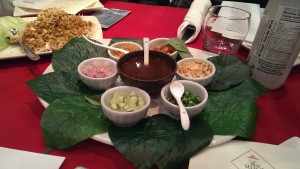
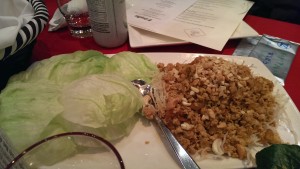
If you look at the first course, the dish that stood out for me was the Chicken and Shrimp Larb. It’s essentially a lettuce wrap with cashews, vermicelli, water chestnuts and nam prik pao. The point of the dish is that it’s customizable. You’ve got a tray of condiments with shallots, lime, peanuts, dried shrimp, toasted coconut and some pretty diabolical little chilies. Think for a moment about the amount of thought that you’d need to put in in order to complement or contrast those. It’s rendered more or less impossible by the number of ingredients and the fact that each mouthful is going to be rendered slightly different by the taste of each diner. Cutting those flavours for reset is really all you can hope for from any beer in this situation.
I’m going to step away from that train of thought for a moment for the next course, which in my case was the Thai Lobster Bisque. Now, I’m given to understand that this is something of a house speciality, and because of that I probably shouldn’t have been surprised by the depth of flavour here. The description says “made with lots and lots and lots of lobsters, a bit of butter and Thai herbs.” They are not kidding around about the lobsters. One of the aromas you get from the bisque is actually chitinous lobster shell, which you might think would be off-putting, but the depth of the flavour is marvelous; the mellow roundness of it. The elegant richness. The bisque is so densely packed with flavour that the cilantro garnish doesn’t make any impact until you get a mouthful. On a scale of one to ten, it put a David Gilmour song in my head.
The main course was served family style and comprised five dishes. It occurs to me that you could probably have paired a beer with any one of these single dishes. The Crispy Beef Panang could possibly do with an Ommegang Hennepin. The Stewed Duck with Chestnuts could possibly have done with a fruity Belgian Dubbel (Black Oak’s version of this would work well here). The issue, really, is that family style service makes that more or less impossible since you’re trying a small amount of each dish. Again, Singha works nicely here by simply reframing each new bite. To be fair, it’s probably more fun that way since everyone at the table is experiencing it in the same way.
I like to think about cuisines that don’t have traditional beer cultures. I like to break down the ingredients and figure out which terpenes they’re like to contain and then cross reference that with hops varieties and theorize about which styles might work with the dish. I’m sure that I’ll continue to do that since it’s fascinating and I’m relatively sure that I’ll see some of the theory borne out as craft beer makes its way to different countries over the next dozen or so years. This experience with Singha is a solid reminder that like the Chicken and Shrimp Larb, it all depends on individual taste.
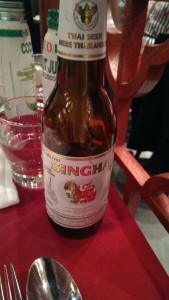
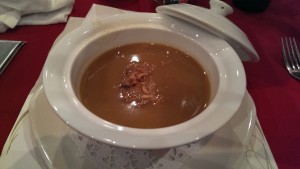
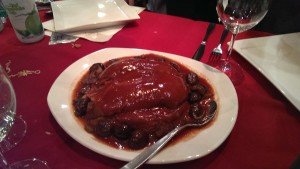
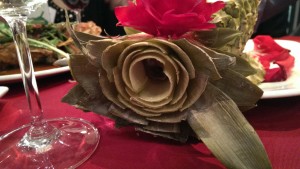
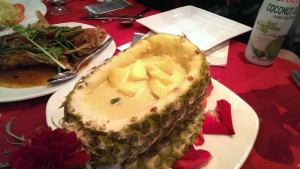
Jordan, thank you for the great and thoughtful write-up. We really enjoyed having you as our guest and am really glad you had a great time. I know the Singha rep was quite excited to meet you and read your write-up as well!